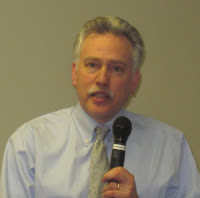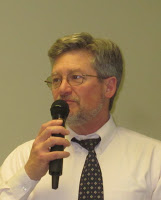Streetcar proposal for Columbia Pike takes shape
 |
| Wolfenstein |
Leaders of the Pike Transit Initiative (PTI) are moving ahead with their project to bring streetcars to the Columbia Pike corridor and plan to bring their proposal to the Fairfax County and Arlington County boards late this summer. There will be public meetings on the proposal in April and May.
If the project is approved, the streetcars could begin operating in 2016 or 2017.
The PTI “is at a critical point,” Leonard Wolfenstein, chief of the transportation section of the Fairfax County Department of Transportation, told members of the Northern Virginia Streetcar Coalition, a citizens advocacy group, at a meeting Feb. 27 at the Goodwin House in Bailey’s Crossroads. During 2011, the PTI brought in experts to develop the project design and review the cost estimates.
The project leaders confirmed the length of the project—from the Skyline Center to Pentagon City—which is about five miles, Wolfenstein said. The streetcars would run on electricity and would be powered by a system of overhead wires and underground feeders. There would be five substations along the route and an operations and maintenance facility at Pentagon City.
There won’t be a dedicated right of way for the streetcars; they will run on existing traffic lanes shared with cars and buses.
 |
| Del Guidice |
The PTI had considered extending the streetcars all the way to the Alexandria campus of Northern Virginia Community College but rejected that option because it would cost an additional $50 million to $10 million, its proximity to wetlands would add a layer of environmental complications, and because property owners at Skyline Plaza were not supportive. “We want to work with people who are willing partners,” said Stephen Del Guidice, Arlington’s Transit Bureau chief.
According to Wolfenstein, the streetcars will bring three major benefits to the Columbia Pike corridor: increased capacity to handle traffic, enhanced access within the corridor and to the regional transit network, and increased economic development along Columbia Pike and in Bailey’s Crossroads.
There are three options under consideration for the terminus at the Skyline Center, said Jason Mumford, project manager with AECOM, the consulting company hired by PTI to design and evaluate the project. Those options include the center of the Skyline Center behind Target (the most expensive option), Route 7 across from the Skyline Center, and along Jefferson Street.
A new transit center is also proposed for Bailey’s Crossroads behind the Olive Garden on Route 7. It would have half a dozen bus bays and about 200 parking spaces, Wolfenstein said. That project could be part of a joint venture as the Bailey’s Crossroads town center is developed.
AECOM compared the streetcar project with other alternatives, including an improved bus system and articulated buses.
The streetcars would handle 26,000 riders a year when they begin operations in 2016-17 and as many as 30,500 by 2030, Mumford said. Many of those users are expected to be residents of the Skyline Center which was built in the early 1970s with the expectation that the development would be served by Metro.
Streetcars are more effective than buses for several reasons, Del Guidice said, although he acknowledged that streetcars “will not significantly improve travel times.” Streetcars are larger and have more doors than buses, he said. A standard bus holds 60 people (including people standing up), while streetcars hold 110. An articulated bus falls somewhere in between.
“People are more likely to ride rail,” he said. And unlike the other options, streetcars would serve as a catalyst for economic development and would enhance the quality of life along the corridor.
Lauryn Douglas, a transportation planner with AECOM, said streetcars would lead to a 4 percent increase in property values adjacent to the right of way—resulting in more tax revenue.
The streetcars would have “off-board fare collection,” which would make boarding the buses faster. “That is key to making this work,” said Del Guidice. Passengers would purchase tickets at transit stops, rather than as they board. He envisions the use of some sort of “smart trip” technology, as well as a paper-ticket option, which would be useful for non-residents.
The streetcars would replace the 16G and H bus routes, but other buses will continue to serve Columbia Pike, Mumford said Arlington is also planning other improvements along Columbia Pike, including streetscape improvements and “more robust bus stop facilities.”
Del Guidice explained why the current cost estimates ($242-261 million in capital costs and $22.5-29.6 for operations and maintenance) are so much higher than those announced in 2007 ($241-231 million plus $19.4-$25.2). The new cost projections take inflation into account and reflect the costs to meet federal building standards, while those done in 2007 don’t.
The 2011 costs include extending the Skyline terminus to Route 7, not all the way to Target, plus structural improvements to the bridge over Four Mile Run.
An enhanced bus system would cost $5 million in capital costs plus $23.3 million for operations and maintenance, while an articulated bus system would cost $53 million for capital costs and $22.5 million for operations and maintenance.
Del Guidice called streetcars a good value when you consider Metro costs about $250 million per mile.
He noted that the Columbia Pike streetcar system might eventually connect with other transit projects under study in Alexandria to run along Route 1, Route 7, and the Beauregard corridor. And once the project is up and running, you can expect a proposal to extend it all the way up Columbia Pike to Annandale.


This will do wonders clogging up Columbia Pike especially during rush hour. It will be like with the buses when people see one getting ready to stop and they speed up and changes last as fast as they can to get around it.
Good thing columbia pike is already hectic at rush hour then. Again, its the capacity increase and the shorter dwell time which should make it easier than getting behind a bus.
This is great news and is a good start at addressing the transportation issues on the pike.
Light rail usually exhibits faster acceleration times, too, compared to buses, so that is likely an improvement as well. (Although I don't know the specifics of this project's technology.)
Nice post good information in this blog . I like very much thanks for sharing